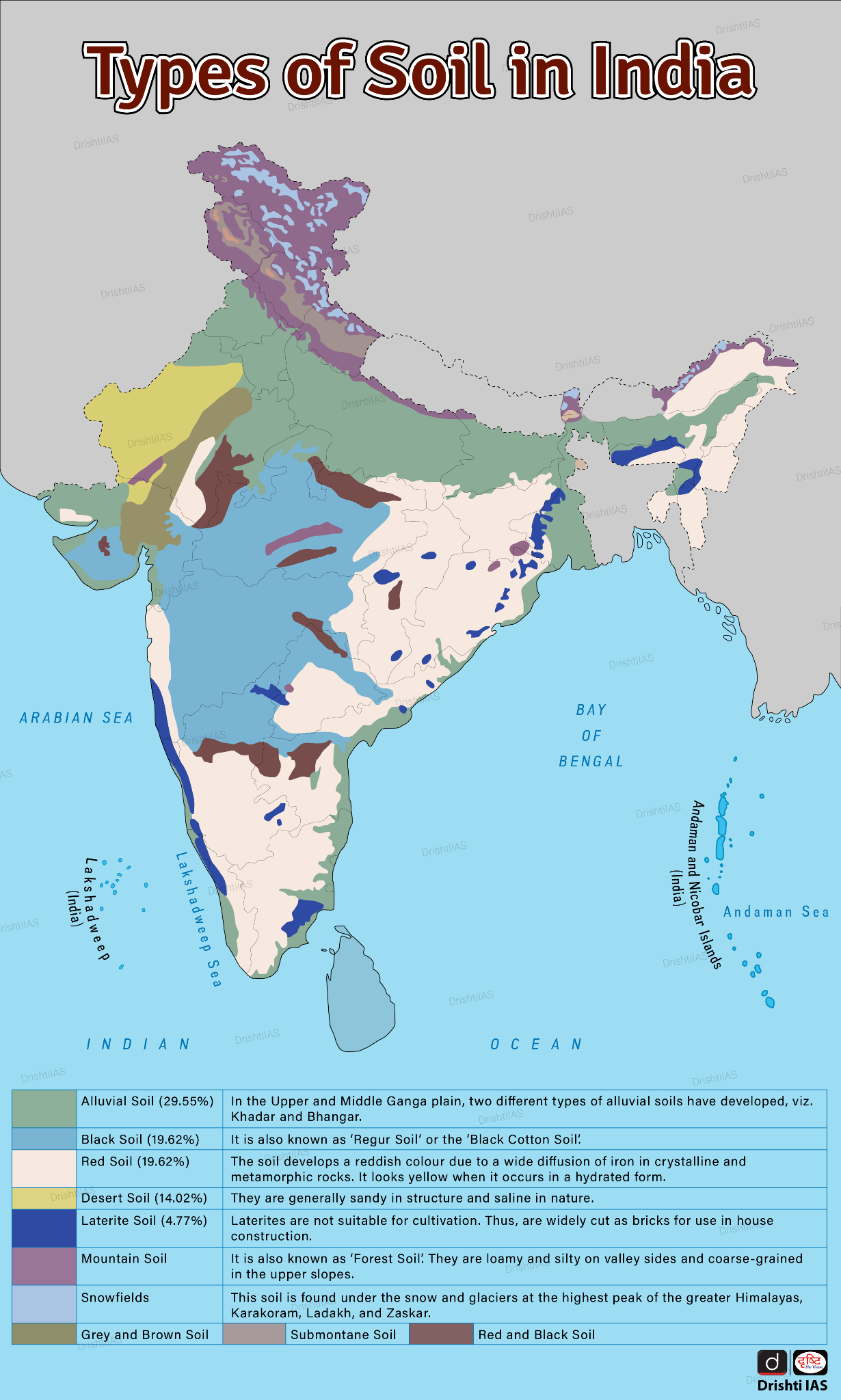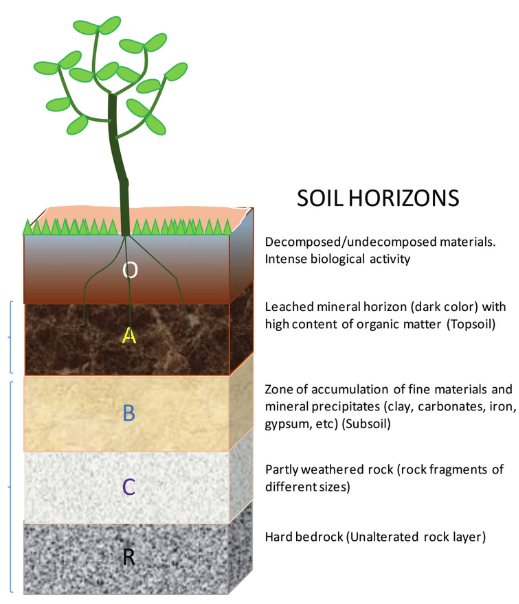Global Soil Conference 2024 and Soil in India | 23 Nov 2024
For Prelims: Soil Health Card Scheme, Pradhan Mantri Krishi Sinchayee Yojana, Zero Budget Natural Farming, Sustainable Development Goal 15, Soil Types in India
For Mains: Soil Health and Sustainability, Sustainable Agricultural Practices, India’s Soil Conservation Efforts
Why in News?
Recently, the Global Soil Conference (GSC) 2024 was held in New Delhi, highlighting the importance of soil health for food security, climate change mitigation, and ecosystem services.
What is the Global Soil Conference 2024?
- About: The GSC 2024, organised by the Indian Society of Soil Science (ISSS) in collaboration with the International Union of Soil Sciences (IUSS), aims to address challenges in sustainable soil/resource management.
- The event aimed to foster a global dialogue on how caring for soils can drive sustainability across various sectors.
- Theme: Caring Soils Beyond Food Security: Climate change mitigation & Ecosystem Services.
- Key Highlights of GSC 2024: Soil health was recognized as a pressing issue, with soil degradation affecting productivity and posing a threat to global food security.
- Around 30% of India's soil is reportedly compromised due to erosion, salinity, pollution, and loss of organic carbon.
- The conference underscored the importance of international cooperation in tackling soil erosion, which aligns with Sustainable Development Goal 15 (SDG 15) of the United Nations.
- SDG 15 aims to protect, restore, and promote the sustainable use of terrestrial ecosystems, manage forests sustainably, combat desertification, halt land degradation, and halt biodiversity loss.
Note:
- The ISSS was established in 1934, in Calcutta under the Societies Registration Act xxi of 1860. The Society organises seminars, and conferences to promote soil science knowledge.
- IUSS is a non-profit, non-governmental scientific society. It is part of the International Science Council (ISC).
- The IUSS promotes soil science research and its applications, fostering global collaboration among scientists.
What are the Concerns Regarding Soil Health in India?
- Soil Degradation: Over one-third of India’s land is at risk of degradation due to unsustainable farming practices and wrong soil management practices.
- Soil Erosion and Loss of Fertility: India loses 15.35 tonnes of soil per hectare annually, reducing crop productivity and causing a loss of 13.4 million tonnes of rainfed crops.
- Soil salinity: Salinity harms soil health by reducing water infiltration, nutrient uptake, and soil aeration, leading to decreased crop productivity.
- It disrupts soil structure, promotes salt-tolerant organisms, and accelerates soil degradation, ultimately making the land infertile.
- Low Organic Content and Nutrient Levels: A major concern is the organic content in the Indian soil is inordinately low (around 0.54%), indicating a deficiency in essential nutrients, which affects soil fertility and agricultural productivity.
- Over 70% of Indian soils suffer from either soil acidity or alkalinity, which disrupts the natural nutrient cycle.
- Additionally, essential nutrients like nitrogen, phosphorus, and potassium are often deficient in Indian soils, further exacerbating the health crisis.
- Desertification: It leads to soil degradation by reducing organic matter, nutrient content, and moisture retention. It results in the loss of soil fertility, causing lower agricultural productivity.
- Desertification accelerates erosion, reduces biodiversity, and makes land unsuitable for farming, worsening food insecurity.
- Diversion of Fertile Land: A significant amount of fertile agricultural land is being diverted for non-agricultural purposes, contributing to the loss of valuable soil resources.
India’s Initiatives for Soil Conservation:
What are the Key Facts About Soil in India?
- Classification of Soils: India's varied relief features, landforms, climatic realms, and vegetation types have contributed to the development of various types of soils.
- Historically, Indian soils were classified into two main groups: Urvara (fertile) and Usara (sterile).
- The Soil Survey of India, established in 1956, and the National Bureau of Soil Survey and Land Use Planning have classified Indian soils based on the United States Department of Agriculture (USDA) Soil Taxonomy, considering genesis, colour, composition, and location.
- Major Soil Types in India:
|
Soil Type |
Distribution |
Characteristics |
Main Crops Grown |
|
Alluvial Soils |
Northern plains, river valleys, deltas of the east coast, and plains of Gujarat |
Vary from sandy loam to clay; rich in potash, poor in phosphorus; Khadar (new alluvium) and Bhangar(older alluvium); colour ranges from light grey to ash grey |
Rice, wheat, sugarcane, cotton |
|
Black Soil |
Deccan Plateau (Maharashtra, Madhya Pradesh, Gujarat, Andhra Pradesh, Tamil Nadu) |
Clayey, deep, impermeable; swells and becomes sticky when wet, shrinks and develops cracks when dry; retains moisture for long periods; rich in lime, iron, magnesia, alumina, and potash; poor in phosphorus, nitrogen, and humus |
Cotton, sorghum, pulses, millets |
|
Red and Yellow Soil |
Eastern and southern Deccan Plateau, parts of Odisha, Chhattisgarh, southern Ganga plain |
Develops on crystalline igneous rocks; red due to iron diffusion, yellow when hydrated; fine-grained soils are fertile, coarse-grained soils in uplands are less fertile; poor in nitrogen, phosphorus, and humus |
Wheat, rice, millets, pulses, groundnut |
|
Laterite Soil |
High temperature and rainfall areas (Karnataka, Kerala, Tamil Nadu, Madhya Pradesh, Odisha, Assam) |
Result of intense leaching; rich in iron oxide and potash, poor in organic matter, nitrogen, phosphate, and calcium |
Cashew, tea, coffee, rubber, coconut |
|
Arid Soil
|
Western Rajasthan, Punjab and Haryana |
Sandy and saline; poor in moisture and humus; high evaporation and calcium content create 'kankar' layers; poor nitrogen, normal phosphate; colour ranges from red to brown |
Barley, cotton, millet, pulses |
|
Saline Soil |
Western Gujarat, eastern coastal deltas, Sunderbans (West Bengal), areas with excessive irrigation (Punjab, Haryana) |
High in sodium, potassium, and magnesium; infertile; saline due to dry climate and poor drainage; poor nitrogen and calcium; salt crust formation due to capillary action in irrigated areas |
Rice, wheat, barley (with gypsum treatment) |
|
Peaty Soil |
Areas with heavy rainfall and high humidity (Northern Bihar, southern Uttarakhand, coastal West Bengal, Odisha, Tamil Nadu) |
High organic matter and humus content; heavy and black; can be alkaline; organic matter up to 40-50%; found in waterlogged and swampy areas |
Rice, jute |
|
Forest Soil |
Forested areas with sufficient rainfall, Himalayas, Western and Eastern Ghats |
Varies in structure and texture; loamy and silty in valleys, coarse-grained in upper slopes; acidic and low in humus in snow-bound areas; fertile in lower valleys |
Tea, coffee, spices, tropical fruits |
Soil Profile
- About: A soil profile is a vertical cross-section of soil, showing different layers (horizons) that vary in texture, colour, and chemical composition.
- Soil Horizons developed through interactions of climate, organisms, and land surface can be organic (O) or mineral (A, E, B, C).
- Key Layers of Soil:
- O Horizon (Organic Layer): Contains undecomposed organic matter like leaves, twigs, and moss.
- A Horizon (Topsoil): Rich in organic matter and minerals, supports plant growth, soft and porous.
- E Horizon (Eluviated Layer): A lighter, nutrient-depleted layer due to leaching (removal of minerals by water).
- B Horizon (Subsoil): Accumulates leached minerals from upper layers; contains iron, clay, and organic compounds.
- C Horizon (Parent Rock): Made up of broken bedrock or saprolite, with little organic matter.
- R Horizon (Bedrock): Unweathered bedrock at the base of the soil profile.
What Can Be Done to Enhance Soil Health?
- Policy: Develop more comprehensive schemes like the SHC, which provides farmers with detailed information about the nutrient status of their soil. This helps in making informed decisions about fertiliser use and soil management.
- Carbon Sequestration: Soil carbon sequestration boosts soil health by storing atmospheric carbon dioxide (CO2) as organic carbon, improving fertility and water retention. Practices like cover cropping and reduced tillage enhance carbon levels and sustainability.
- Sustainable Farming Practices: India can adopt large-scale no-till farming, as successfully implemented in Brazil, to improve soil health, reduce erosion, and boost crop yields.
- This sustainable practice ensures better productivity and environmental conservation.
- Sustainable Farming practices like crop rotation, agroforestry and organic farming are vital for soil health and environmental conservation.
Conclusion
The Global Soil Conference 2024 highlighted the need for sustainable soil management to ensure food security and climate resilience. India must adopt better farming practices and policies to address soil degradation. Strengthening soil health is crucial for long-term agricultural and economic sustainability.
|
Drishti Mains Question: Soil health is integral to ensuring food security." Discuss the challenges faced by India regarding soil degradation and propose sustainable solutions. |
UPSC Civil Services Examination, Previous Year Questions (PYQs)
Prelims
Q. The black cotton soil of India has been formed due to the weathering of
(a) brown forest soil
(b) fissure volcanic rock
(c) granite and schist
(d) shale and limestone
Ans: (b)
Exp:
- Black soil, also known as regur soil or black cotton soil, is ideal for growing cotton. The climatic conditions along with the parent rock material are the important factors for the formation of black soil. Black soil is typical of the Deccan trap (Basalt) region spread over northwest Deccan plateau and is made up of lava flows (fissure volcanic rock).
- The Deccan Plateau includes parts of Maharashtra, Madhya Pradesh, Gujarat, Andhra Pradesh and some parts of Tamil Nadu. Black soil also covers upper reaches of the Godavari and the Krishna, and the north Maharashtra, Madhya Pradesh, Gujarat, Andhra Pradesh and some parts of Tamil Nadu.
- Chemically, the black soils are rich in lime, iron, magnesia and alumina. They also contain potash. But they lack phosphorus, nitrogen and organic matter. The colour of the soil ranges from deep black to grey.
- Therefore, option (b) is the correct answer.
Q. Which of the following statements regarding laterite soils of India are correct? (2013)
- They are generally red in colour.
- They are rich in nitrogen and potash.
- They are well-developed in Rajasthan and UP.
- Tapioca and cashew nuts grow well on these soils.
Select the correct answer using the codes given below:
(a) 1, 2 and 3
(b) 2, 3 and 4
(c) 1 and 4
(d) 2 and 3 only
Ans: (c)


